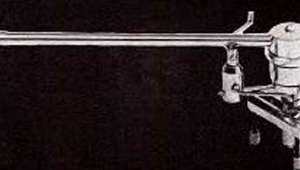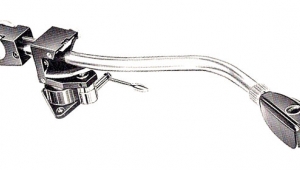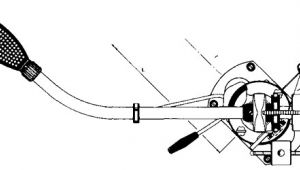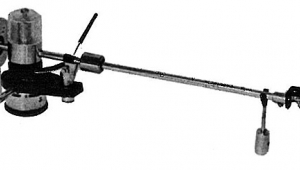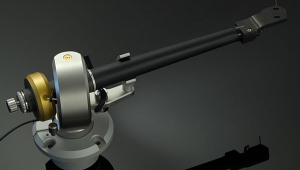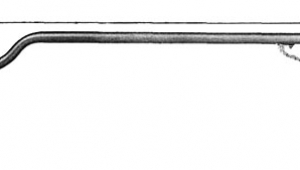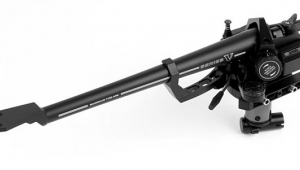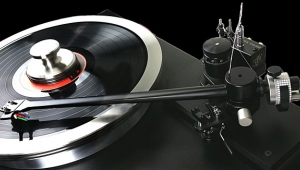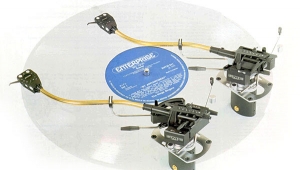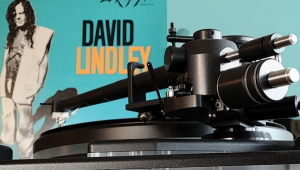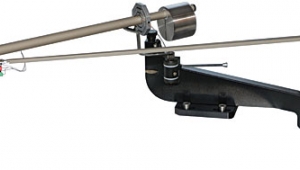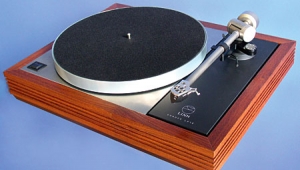| Columns Retired Columns & Blogs |
Airtangent tonearm
Tonearms, like Rodney Dangerfield, never get no respect. When was the last time you heard someone actually argue the merits of a tonearm? Right, not recently. "Hey, I just got that new Gizmo tonearm!" "Oh yeah? What cartridge are you using?" People pick out the cartridge for praise and consideration time after time, while the tonearm gets taken for granted.
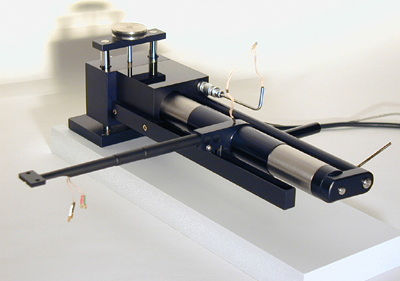
Change the material of the wires in the tonearm, or the interconnects to the preamp, and, granted, you'll get more attention than having switched to a tonearm with, say, an azimuth adjustment. After all, how much can it matter? The tonearm is not in the direct path of the signal. All it does is hold the cartridge, and as long as the geometry and VTF are within reason, it's doing a good job. Once again—no respect.
But the tonearm's role goes well beyond a mere support function. Due to its early appearance in the playback hierarchy, the tonearm can have a profound influence on the overall outcome of the musical event. And that's without touching on any functional or even aesthetic aspects of this component.
As a matter of fact, I submit that the tonearm is not only the most active, but also the most influential component in your system. Every time a record is played, the tonearm is involved. It's an integral part of the playback ritual. The tonearm not only points the cartridge in the right direction, it also cues over to the right spot, raises the cartridge, and lowers it into the groove.
But it's not until the stylus settles into the groove that the tonearm becomes a crucial, active component of the reproduction chain. Besides having to keep the cartridge in step with the advancing spiral of the groove itself, the tonearm has to bear the swings and narrows of outrageous excursions. With luck, these will be recorded information, but anomalies of the black disc also have to be accommodated.
Consider this analogy: A pair of binoculars can be the brightest and the best, but if you don't hold them still the magnification and resolution are wasted. Gripping them in your hands is not enough; even with your elbows pressed to your sides, all you will see is a blur—the image wanders, jitters, and drifts. But if the elbows are supported on something firm, like a wall, everything steadies. Put the binoculars on a tripod, and the results are rock-solid.
The tonearm has a similarly vexing task, only carried a step further. Take the same binoculars to a floating boat, stand up in it, and now try to sight on something far away. Better still, look at a bird in flight.
Well, a stylus riding a record groove has similar requirements. The cartridge has to be held rigidly and perfectly aligned by the tonearm in order to avoid image shifts, blurred transients, grundge, and the like. Except for one small problem—the groove is a moving target. It is cut in a spiral, requiring the tonearm to keep up with this path. The pressing could also be off-center, or worse, warped. It's a one-shot deal, in real time no less, without the benefit of error correction.
The tonearm, acting from a shifting reference position, has to provide the cartridge with enough steadying influence to allow the stylus to correctly garner every recorded nuance from the speeding record groove. And as if all that was not enough, the requirements also include adjustments for VTF, VTA, azimuth, and overhang.
Granted, it's complicated. But is the tonearm really influential? Most definitely. The point is that a tonearm can make or break (oops, poor choice of words, here in the world of megabuck cartridges) a cartridge. A cartridge cannot do the same for a tonearm.
For once, you're not at the mercy of garbage in, garbage out; instead, you're in a position to minimize it. What we have here is a case for generating minimum distortion at the point where the signal originates. It has been said before, and I'll say it again—if you don't get it right at the beginning, forget it.
The tonearm is there to make the cartridge look good by customizing its relationship to the groove, which, in turn, will optimize the interpolation of the recorded information. Here I refer to more than just the built-in facilities for trimming VTA and azimuth settings. We have now entered the subtle world of structural resonances, bearing stiffness, and similarly complex design problems. We have also crossed an imaginary line separating the engineering world from the realm of art.
Respectfully, I rest my case.
Fortunately, there are individuals who not only respect tonearms, but who are committed to perfecting them. One of these people, Leif Haggmark, designer and developer of the Airtangent tonearm and the Swedish Magnepan and Krell distributor, has left no room for doubt about his commitment.
The idea behind this tonearm was to accomplish everything I have discussed and then some. That "then some" includes low moving mass in both planes, controlled resonances in the armtube, and user conveniences galore. Also, the finish is excellent, the design admirable, and the execution stunning.
Obviously, a very exciting product. But there must be a catch somewhere. There is—it costs $3200. Sure, the Airtangent is imported from Sweden, but the biggest reason is the small number of audiophiles who partake of such sumptuous goodies. It's a case of supply and demand—of performance, that is.
- Log in or register to post comments
